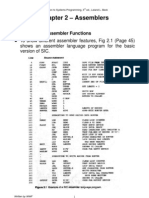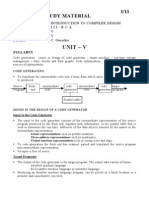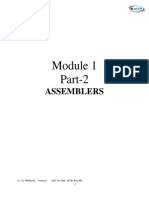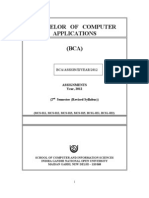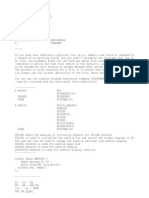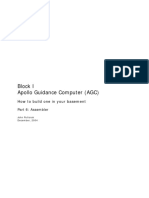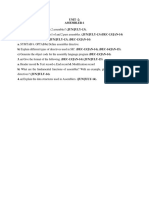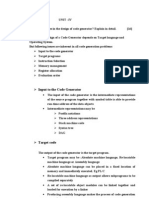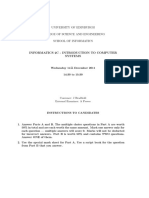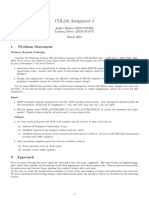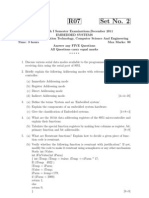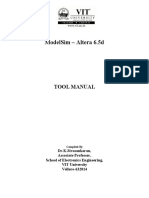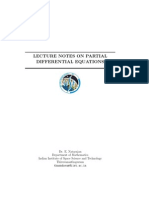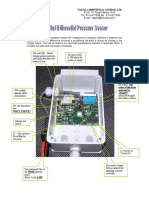Scripting TCL/Perl
Scripting TCL/Perl
Uploaded by
Ravi Tej GunisettyCopyright:
Available Formats
Scripting TCL/Perl
Scripting TCL/Perl
Uploaded by
Ravi Tej GunisettyOriginal Description:
Copyright
Available Formats
Share this document
Did you find this document useful?
Is this content inappropriate?
Copyright:
Available Formats
Scripting TCL/Perl
Scripting TCL/Perl
Uploaded by
Ravi Tej GunisettyCopyright:
Available Formats
Term End Examination - September 2013
Class NBR
Course Code
Course Title
Time : Three Hours
: 1022
Slot : A2+TA2
: EEE575
: Scripting Languages and
Verification
Max.Marks:100
Answer ALL Questions
(10 X 10 = 100 Marks)
1.
[5]
a) Describe the operation and the result in PERL
i) /^\s*$/;
ii) /^\s*\S+\s+\S+\s+\S+\s*$/;
iii) $_=Dar21 presents;
iv) /^\s*([a-zA-Z]+)/; print $1;
v) /^\s*(\W+)/; print $1;
b) Write a Perl script to create an array that contains the names of 10 students of a class.
[5]
Print the array. Add that names at the end and beginning of array. Print the array. Ask
user to input a number. Print the name that has that number as index. Remove last
and starting element of array. Print the array in alphabetical and in reverse order.
2.
Write a Perl script which will read a mathematical sentence from the user, evaluate the
[10]
result, and print the result to the screen. For example, if the user types
2 + 4 = the program will output 6. The result should be written in output file. All
formulas will be given in the format Operand_1 Operator Operand_2 =
The characters in the formulas may or may not be separated by white space. The
operators that must be supported are: +, - , / , * , % .
3.
[5]
a) I) Create regular expressions that:
i) match any floating point number.
ii) match the following tree words a507, b702, c334.
iii) swap the two words of the following string 45 67.
II) Give the string example which satisfies the following perl regular expressions
i) /(\w+\s+)(\w+)(\s+\w+)/
ii) s/[ \t]+\n$/\n/.
b) Write a perl program that reads a number and then a list of strings (all on separate
lines), and then prints one of the lines from the list as selected by the number.
Page 1 of 5
[5]
4.
a) Write a TCL Script to Reverse the elements of a List using a While and a FOR loop.
[5]
b) Create a new TCL command called ldelete which deletes a particular element in a
[5]
list, It takes two arguments a list and a value , it deletes the element specified by the
value.
5.(a)
Create a new TCL command called Fibonacci which generates Fibonacci series but
[10]
the no. of elements generated is limited by an integer value specified as argument to the
command.
OR
5.(b)
Write a perl script that prints those mosfets that act as moscaps. The drain, source and
[10]
bulk of mosfet are connected to the same net and the gate is connected to the other net.
6.(a)
Consider the following state transition diagram of the lift controller of block, which has
[10]
three floors. The states are encoded using a 2 bit bus, whereas the inputs are denoted by
2 bits. There are 3 states, one corresponding to each floor, denoted by L0, L1 and L2.
The state 0, denoted by L0 is the initial state. The labels on the arrows represent the valid
inputs received by the controller, which can be 0, 1 or 2. Using the state space approach
derive test scenarios to detect bugs in the state transition diagram. Based on it redraw a
more correct state transition diagram which takes care of the corner cases.
i) Which verification topology and test cases are used to verify the above controller?
ii) Write the verification scenarios to verify the lift controller
State transition diagram of Lift controller
OR
6.(b)
There are two bus masters linked to a central arbiter by individual request (REQ#) and
grant (GNT#) signals. Each master has its own REQ# and GNT# lines. Apart from this
the arbiter also receives an input reset (RST#) signal. Consider the following timing
specification: Whenever the signal RST# is deasserted and in the next clock cycle REQ#
is asserted, the GNT# signal is asserted after 3 clock cycles after the REQ# assertion and
remains high for 7 clock cycles.
Write verilog BFM code to model the above specification with timing diagram.
Page 2 of 5
[10]
7.
Dual port RAM (DPRAM) provides a common memory accessible to 2 processors that
can be used to share and transmit data and system status between two processors.
Consider a DPRAM wrapper in verilog:
dram(addr0, data0, addr1, data1)
The dimension of the data bus is 1 bit and that of the address bus is 4 bits. The wrappers,
written in verilog has tasks read_memory and write_memory which you can invoke
from a top level testbench.We also have suitable wrappers for the verilog codes for a
processor:
cpu(busy,addr,data,control)
The control and busy bits are 1 bit each and the data and address are as that of the
DPRAM.
A block named TestnSet probes two processors P0 and P1 which share a DPRAM. The
processors are connected to port0 and port1 of a shared DPRAM (refer Fig). The block
named TestnSet maintains two special 1 bit registers sreg0 and sreg1 and two 1 bit flag
registers, flag0 and flag1. If the control bit of P0 goes high with the address value as say
A, then the content of the memory is brought to the sreg0 and flag0 is set high. If P1s
control bit also goes high and address value is also A, then P1 busy should be high.
Otherwise there is an error. Irrespective of what happens to P1, the sreg0 register will be
checked and if the value is 0, the content of data0 bus will be written to the address A. If
the sreg0 register is 1, no write takes place.
a) Write the BFM tasks for read memory and write memory.
b) Write a testcase using BFM tasks to do write and read operation of both processors.
Page 3 of 5
[10]
8.
Communications (on both sides) takes place by means of a 4-phase handshaking as
[10]
follows:
When the sender has data to send to the receiver, it initiates a transfer by putting the data
on the data bus and asserting StoB_REQ (Server to Buffer REQuest). If BUF is free, it
reads the data and asserts BtoS_ACK (Buffer to Server ACKnowledge). Otherwise the
sender waits. After seeing BtoS_ACK, the sender may release the data bus and deassert
StoB_REQ. To conclude the transaction, BUF deasserts BtoS_ACK.
When BUF has data, it initiates a transfer to the receiver by putting the data on the data
bus and asserting BtoR_REQ (Buffer to Receiver REQuest). If the receiver is ready, it
reads the data and asserts RtoB_ACK (Receiver to Buffer ACKnowledge). Otherwise,
BUF waits. After seeing RtoB_ACK, BUF may release the data bus and deassert
BtoR_REQ. To conclude the transaction, the receiver deasserts RtoB_ACK.
a) Develop the BFM Tasks for buffer module.
b) Develop suitable verification methodology and test scenarios.
9.
a) A communication device receives a clock upto M MHz. Write a verilog code snippet
[5]
to verify that the clock meets this timing requirement.
b) What is the significance of seed in randomization and draw the random verification
methodology?
Page 4 of 5
[5]
10.
[10]
Define the code coverage metrics and write the different coverage metrics in the
following code
module
s1: begin
else begin
sequence_detector( clk,rst,
if (x==1'b1) begin
ns = s0;
x, y);
ns = s1;
y = 1'b0;
input x,clk,rst;
y = 1'b0;
end
output y;
end
end
reg y;
else begin
endcase
reg [1:0] ns, ps;
ns = s2;
end
parameter s0 = 2'b00;
y = 1'b0;
always @( posedge
parameter s1 = 2'b01;
end
clk or posedge rst)
parameter s2 = 2'b10;
end
begin
always @ ( x or ps)
begin
s2: begin
if ( rst)
if (x==1'b1) begin
ps <= s0;
case( ps)
ns = s1;
else
s0: begin
y=1'b1;
ps <= ns;
if (x==1'b1) begin
end
ns = s1;
end
endmodule
y = 1'b0;
end
else begin
ns = s0;
y = 1'b0;
end
end
Page 5 of 5
You might also like
- Design of Analog CMOS Integrated Circuits, Solutions (McGraw) - RAZAVIDocument329 pagesDesign of Analog CMOS Integrated Circuits, Solutions (McGraw) - RAZAVImtechsurendra12379% (33)
- Cheat Sheet For NetworkingDocument2 pagesCheat Sheet For Networkingdude100% (3)
- ParaphraseDocument51 pagesParaphrasevincent tekeyNo ratings yet
- Chapter 2-Assemblers (New)Document45 pagesChapter 2-Assemblers (New)Bozz Mob75% (4)
- I/A Series Hardware Channel Isolated, Discrete I/O Interface Module (FBM241/FBM241b/FBM241c/FBM241d)Document8 pagesI/A Series Hardware Channel Isolated, Discrete I/O Interface Module (FBM241/FBM241b/FBM241c/FBM241d)Thomas BORNEY100% (1)
- PDFDocument5 pagesPDFDebolina RoyNo ratings yet
- Unit - V: Study Material 1/11Document11 pagesUnit - V: Study Material 1/11kannansa23No ratings yet
- Module-1 Part2 AssemblersDocument24 pagesModule-1 Part2 AssemblerssrinivasNo ratings yet
- AET305 Dec 2023Document2 pagesAET305 Dec 2023tve22ae062No ratings yet
- Nited Nstitute of EchnologyDocument11 pagesNited Nstitute of Echnologykeerthi3214No ratings yet
- Indian Institute of Technology, Kharagpur: Mid-Spring Semester 2021-22Document4 pagesIndian Institute of Technology, Kharagpur: Mid-Spring Semester 2021-22Utkarsh PatelNo ratings yet
- AS400 Iseries Tips Tricks Guides Revision Notes LearningsDocument34 pagesAS400 Iseries Tips Tricks Guides Revision Notes LearningsVISHNU400No ratings yet
- Assembler 1Document28 pagesAssembler 1srinivasNo ratings yet
- CO-PROBLEMS-UNIT-2Document28 pagesCO-PROBLEMS-UNIT-219ME535 Mohd HuzaifNo ratings yet
- SsDocument15 pagesSsAnonymous HIAYtiNo ratings yet
- CRC of BCA (2) Assignment (Revised Syllabus)Document17 pagesCRC of BCA (2) Assignment (Revised Syllabus)BshrinivasNo ratings yet
- First Term Examination 2015-16 Subject: Computer Science Grade: XII Max. Marks: 70 Time: 3 Hrs General InstructionsDocument9 pagesFirst Term Examination 2015-16 Subject: Computer Science Grade: XII Max. Marks: 70 Time: 3 Hrs General InstructionsRohan ChackoNo ratings yet
- LoaderDocument20 pagesLoaderEbnazer JamesNo ratings yet
- (SS) System Software Viva Question and AnswersDocument15 pages(SS) System Software Viva Question and AnswersVenkatesh NaiduNo ratings yet
- Lab Manual: Microprocessor Lab (8086) Sub Code: 06CSL48Document100 pagesLab Manual: Microprocessor Lab (8086) Sub Code: 06CSL48Vaishali VaishuNo ratings yet
- AS400 Iseries Tips Tricks Guides Revision Notes LearningsDocument33 pagesAS400 Iseries Tips Tricks Guides Revision Notes LearningsKapil100% (1)
- Block I Apollo Guidance Computer (AGC) : How To Build One in Your BasementDocument20 pagesBlock I Apollo Guidance Computer (AGC) : How To Build One in Your BasementpabloNo ratings yet
- Chapter 2 ProposedDocument62 pagesChapter 2 Proposedvincent tekeyNo ratings yet
- Compiler Unit 5 NotesDocument20 pagesCompiler Unit 5 NotesVidhi TanwarNo ratings yet
- SARAVANA12Document10 pagesSARAVANA12VETRIZONE SRIVETRINo ratings yet
- Lab 4Document18 pagesLab 4Vuong PhạmNo ratings yet
- Unit 4 CompilerDocument19 pagesUnit 4 CompilerLatha Rajamanickam RNo ratings yet
- Rajalakshmi Engineering College: CS2308 - SS Lab VVQ Unit I-IntroductionDocument17 pagesRajalakshmi Engineering College: CS2308 - SS Lab VVQ Unit I-IntroductionssarvinthNo ratings yet
- Assignment 1 - CSE211 RGDocument4 pagesAssignment 1 - CSE211 RGSurya TyagiNo ratings yet
- 350 401.v2022 02 14.q176Document101 pages350 401.v2022 02 14.q176Abebe BelachewNo ratings yet
- IAT-V Question Paper With Solution of 18CS72 Big Data Analytics Feb-2022-Poonam Vijay TijareDocument10 pagesIAT-V Question Paper With Solution of 18CS72 Big Data Analytics Feb-2022-Poonam Vijay TijareDarshan R GowdaNo ratings yet
- Directives? (JUN/JULY-14)Document9 pagesDirectives? (JUN/JULY-14)Binu KoshyNo ratings yet
- Annauniv 5thsem Sytsemsoftware Students CornersDocument21 pagesAnnauniv 5thsem Sytsemsoftware Students CornersstudentscornersNo ratings yet
- MPMC LAB Manual R20Document49 pagesMPMC LAB Manual R20vasudevanandhasrividya16No ratings yet
- TA GC 162 Computer Programming 1Document4 pagesTA GC 162 Computer Programming 1sachnish123No ratings yet
- Interview Questions About VerilogDocument14 pagesInterview Questions About VerilogKiran ReddyNo ratings yet
- Bcs Higher Education Qualifications BCS Level 4 Certificate in ITDocument8 pagesBcs Higher Education Qualifications BCS Level 4 Certificate in ITJessica TiffanyNo ratings yet
- Lab MicroprocessorsDocument45 pagesLab MicroprocessorsSweetsoulUroojMalikNo ratings yet
- Input To The Code GeneratorDocument62 pagesInput To The Code Generatorneotheone24No ratings yet
- Microprocessor Lab1Document3 pagesMicroprocessor Lab1kidu100% (1)
- Inf2c Cs 201112Document9 pagesInf2c Cs 201112davidcorreobasura1No ratings yet
- 15MPE1019Document12 pages15MPE1019Polumuri RamanaNo ratings yet
- MapDocument23 pagesMapshaikh farhanNo ratings yet
- Microprocessors and Interfacing November Am Rr311903Document8 pagesMicroprocessors and Interfacing November Am Rr311903Nizam Institute of Engineering and Technology LibraryNo ratings yet
- cs2304 System Software 2 Marks and 16 Marks With AnswerDocument18 pagescs2304 System Software 2 Marks and 16 Marks With Answermanojkumar024No ratings yet
- 9A04602 Microprocessors & Microcontrollers5Document1 page9A04602 Microprocessors & Microcontrollers5subbuNo ratings yet
- Su 2011 Final SolDocument19 pagesSu 2011 Final SolmissionchocolateNo ratings yet
- Rr322203 Microprocessors MicrocontrollersDocument8 pagesRr322203 Microprocessors Microcontrollersgeddam06108825No ratings yet
- MPMC LAB Manual R20-1Document50 pagesMPMC LAB Manual R20-1bmn889735No ratings yet
- COL216 Assignment 4: 1 Problem StatementDocument4 pagesCOL216 Assignment 4: 1 Problem StatementAniket MishraNo ratings yet
- R07 Set No. 2Document5 pagesR07 Set No. 2Krishna MoorthyNo ratings yet
- The Elements of Computing Systems, second edition: Building a Modern Computer from First PrinciplesFrom EverandThe Elements of Computing Systems, second edition: Building a Modern Computer from First PrinciplesNo ratings yet
- Programming Your GPU with OpenMP: Performance Portability for GPUsFrom EverandProgramming Your GPU with OpenMP: Performance Portability for GPUsNo ratings yet
- CISCO PACKET TRACER LABS: Best practice of configuring or troubleshooting NetworkFrom EverandCISCO PACKET TRACER LABS: Best practice of configuring or troubleshooting NetworkNo ratings yet
- UNIX Shell Programming Interview Questions You'll Most Likely Be AskedFrom EverandUNIX Shell Programming Interview Questions You'll Most Likely Be AskedNo ratings yet
- Practical Reverse Engineering: x86, x64, ARM, Windows Kernel, Reversing Tools, and ObfuscationFrom EverandPractical Reverse Engineering: x86, x64, ARM, Windows Kernel, Reversing Tools, and ObfuscationNo ratings yet
- Essentials of Compilation: An Incremental Approach in RacketFrom EverandEssentials of Compilation: An Incremental Approach in RacketNo ratings yet
- Introduction to Computer Organization: An Under the Hood Look at Hardware and x86-64 AssemblyFrom EverandIntroduction to Computer Organization: An Under the Hood Look at Hardware and x86-64 AssemblyNo ratings yet
- WAN TECHNOLOGY FRAME-RELAY: An Expert's Handbook of Navigating Frame Relay NetworksFrom EverandWAN TECHNOLOGY FRAME-RELAY: An Expert's Handbook of Navigating Frame Relay NetworksNo ratings yet
- An Introduction To LaTeXDocument46 pagesAn Introduction To LaTeXScribd_rkc100% (7)
- Power Play Earlypower EstimatorDocument48 pagesPower Play Earlypower EstimatorRavi Tej GunisettyNo ratings yet
- Vit AssignmentDocument2 pagesVit AssignmentRavi Tej GunisettyNo ratings yet
- ModelSim TutorialDocument12 pagesModelSim TutorialRavi Tej GunisettyNo ratings yet
- Hybrid-Type CAM Design For Both Power and Performance EfficiencyDocument10 pagesHybrid-Type CAM Design For Both Power and Performance EfficiencyRavi Tej GunisettyNo ratings yet
- Resume and Cover Letters-HarvardDocument16 pagesResume and Cover Letters-HarvardVinod Joshi100% (1)
- Design of Io PadDocument3 pagesDesign of Io PadRavi Tej GunisettyNo ratings yet
- Digital Experiment 2Document12 pagesDigital Experiment 2Ravi Tej GunisettyNo ratings yet
- Thank You For Your Order!: G G PrasunambaDocument1 pageThank You For Your Order!: G G PrasunambaRavi Tej GunisettyNo ratings yet
- Programmable LED Marquee: COMP SCI 353 Computer Architecture and Organization Project Fall 2006 Daniel KellyDocument30 pagesProgrammable LED Marquee: COMP SCI 353 Computer Architecture and Organization Project Fall 2006 Daniel KellyAbdelrahim Hussam MoubayedNo ratings yet
- Lecture Notes On Partial Differential EquationsDocument35 pagesLecture Notes On Partial Differential Equationscgpa9_9barNo ratings yet
- Kendriya Vidyalaya NoDocument9 pagesKendriya Vidyalaya NoPrachi SharmaNo ratings yet
- ECE Reviewer 1Document14 pagesECE Reviewer 1magatNo ratings yet
- 526 D-7e Electric Smoke IndicatorDocument31 pages526 D-7e Electric Smoke IndicatorKos KosNo ratings yet
- 8230e DELL Vostro 3350 Wistron Nirvana 13Document104 pages8230e DELL Vostro 3350 Wistron Nirvana 13sopteaNo ratings yet
- RF Transistor List: Bipolar NPN Power TransistorDocument5 pagesRF Transistor List: Bipolar NPN Power TransistorAnonymous XoW23y58O100% (3)
- TE FMT Series Fiber Optic PanelDocument17 pagesTE FMT Series Fiber Optic PaneltuansanleoNo ratings yet
- Microwave Planing Training GuideDocument111 pagesMicrowave Planing Training Guidenbonina100% (2)
- HMZ - 433 Sensor de HumedadDocument4 pagesHMZ - 433 Sensor de HumedadLeo BarrazaNo ratings yet
- Circuit Bending: Speak and Read and Omnichord!Document14 pagesCircuit Bending: Speak and Read and Omnichord!FVNo ratings yet
- Manual 3 - Eleganza 1Document30 pagesManual 3 - Eleganza 1MarcoNo ratings yet
- Functional Symbols Current Rev Desc:: Dimension Units ScaleDocument2 pagesFunctional Symbols Current Rev Desc:: Dimension Units ScaleCarlos ParapeNo ratings yet
- Air DolphinDocument4 pagesAir DolphinChristian Mena CervantesNo ratings yet
- ANSI C57 12 52 1981 Dry TXsDocument18 pagesANSI C57 12 52 1981 Dry TXsJhon agapitoNo ratings yet
- Ultrasonic Testing Report (Structural) (Completed Weld Tubular / Non Tubular)Document3 pagesUltrasonic Testing Report (Structural) (Completed Weld Tubular / Non Tubular)Anna PariniNo ratings yet
- Three Phase Load CalculatorDocument1 pageThree Phase Load CalculatorErdincNo ratings yet
- ZEROSHELL Internet Redundancy and BalancingDocument6 pagesZEROSHELL Internet Redundancy and BalancingRapacitorNo ratings yet
- Hidden Active Cell Phone Detector: April 2018Document7 pagesHidden Active Cell Phone Detector: April 2018Geofrey BariyaaNo ratings yet
- Justification Report Esp Proportioning Transformer NewDocument4 pagesJustification Report Esp Proportioning Transformer NewxuchickNo ratings yet
- Street Light EstimateDocument13 pagesStreet Light EstimateSantosh ChowdaryNo ratings yet
- INetVu Brochure August2014NEWDocument8 pagesINetVu Brochure August2014NEWSeyedBehnamMohammadiNo ratings yet
- DP External Manual ENGDocument3 pagesDP External Manual ENGtsikasNo ratings yet
- Terra CanDocument530 pagesTerra CanEduardo FloresNo ratings yet
- Float Type Level SwitchesDocument5 pagesFloat Type Level SwitchesMd. Mamon RanaNo ratings yet
- AIIMS Solved Paper 2017Document30 pagesAIIMS Solved Paper 2017Jagmohan SinghNo ratings yet
- Arafat MahmudDocument2 pagesArafat MahmudshetuNo ratings yet
- Caution:: Ages 4 and UpDocument2 pagesCaution:: Ages 4 and UposcargorrinNo ratings yet
- BOM MHP PanelDocument11 pagesBOM MHP PanelPritam SinghNo ratings yet
- Orbit Barcode Scanner Ms7120Document44 pagesOrbit Barcode Scanner Ms7120Jesus UrrietaNo ratings yet
- VOS Startup and Shutdown A System (r282-03)Document198 pagesVOS Startup and Shutdown A System (r282-03)kennycheungNo ratings yet



